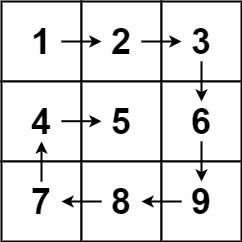Given an m x n matrix, return all elements of the matrix in spiral order.
Example 1:

Input: matrix = [[1,2,3],[4,5,6],[7,8,9]]
Output: [1,2,3,6,9,8,7,4,5]
Example 2:

Input: matrix = [[1,2,3,4],[5,6,7,8],[9,10,11,12]]
Output: [1,2,3,4,8,12,11,10,9,5,6,7]
Constraints:
m == matrix.length
n == matrix[i].length
1 <= m, n <= 10
100 <= matrix[i][j] <= 100
給定一個矩陣 matrix
要求寫一個演算法透過 順時針螺旋的順序來把矩陣轉換成陣列
可以注意到 spiral order
每次拆分成成四個部份
最上層由左往右走訪
最右層由上往下走訪
最下層由右往左走訪
最左層由下往上走訪

可以注意到每次走訪完一層 就可以把走訪的該層 排除,範圍縮小
比如說當最上層走到最右邊時,就可以把 top 更新為 top +=1
這樣每次移動 top, left , bottom, right 指標直到 top == bottom || left == right
逐步把每個走訪的元素放到新的陣列內

時間複雜度是 O(m*n) where n = len(matrix), m = len(matrix[0])
空間複雜度是 O(m*n) 回傳的陣列長度
package sol
func spiralOrder(matrix [][]int) []int {
result := []int{}
top, bottom := 0, len(matrix)
left, right := 0, len(matrix[0])
for top < bottom && left < right {
//top layer: go left
for col := left; col < right; col++ {
result = append(result, matrix[top][col])
}
top++
//right layer: go down
for row := top; row < bottom; row++ {
result = append(result, matrix[row][right-1])
}
right--
if top == bottom || left == right {
break
}
//bottom layer: go right
for col := right - 1; col >= left; col-- {
result = append(result, matrix[bottom-1][col])
}
bottom--
//left layer: go up
for row := bottom - 1; row >= top; row-- {
result = append(result, matrix[row][left])
}
left++
}
return result
}
